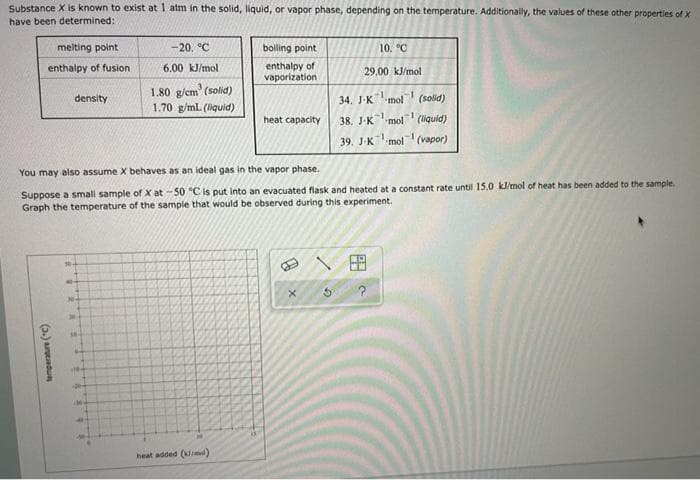Substance X is known to exist at 1 atm in the solid, liquid, or vapor phase, depending on the temperature. Additionally, the values of these other properties of xe have been determined: melting point -20. °C boiling point 10. "C enthalpy of vaporization enthalpy of fusion 6.00 kJ/mol 29.00 kl/mol 1.80 g/cm (solid) 1.70 g/ml (liquid) 1- density 34. J-Kmol (solid) heat capacity 38. J-Kmol (liquid) 39. J-K mol (vapor)
Substance X is known to exist at 1 atm in the solid, liquid, or vapor phase, depending on the temperature. Additionally, the values of these other properties of xe have been determined: melting point -20. °C boiling point 10. "C enthalpy of vaporization enthalpy of fusion 6.00 kJ/mol 29.00 kl/mol 1.80 g/cm (solid) 1.70 g/ml (liquid) 1- density 34. J-Kmol (solid) heat capacity 38. J-Kmol (liquid) 39. J-K mol (vapor)
Chemistry: Principles and Practice
3rd Edition
ISBN:9780534420123
Author:Daniel L. Reger, Scott R. Goode, David W. Ball, Edward Mercer
Publisher:Daniel L. Reger, Scott R. Goode, David W. Ball, Edward Mercer
Chapter11: Liquids And Solids
Section: Chapter Questions
Problem 11.45QE
Related questions
Question
3

Transcribed Image Text:Substance X is known to exist at 1 atm in the solid, liquid, or vapor phase, depending on the temperature. Additionally, the values of these other properties of X
have been determined:
melting point
-20. °C
bolling point
10. °C
enthalpy of
vaporization
enthalpy of fusion
6.00 kJ/mol
29.00 kJ/mol
1.80 g/cm' (solid)
1.70 g/mL (liquid)
density
34. J-Kmol (solid)
heat capacity
38. J-K
mol (liquid)
39. J-K
-1
mol
(vapor)
You may also assume X behaves as an ideal gas in the vapor phase.
Suppose a small sample of X at -50 °C is put into an evacuated flask and heated at a constant rate until 15.0 kl/mol of heat has been added to the sample.
Graph the temperature of the sample that would be observed during this experiment.
田
heat added (i)
(2.) artadu
Expert Solution
This question has been solved!
Explore an expertly crafted, step-by-step solution for a thorough understanding of key concepts.
Step by step
Solved in 5 steps with 5 images

Knowledge Booster
Learn more about
Need a deep-dive on the concept behind this application? Look no further. Learn more about this topic, chemistry and related others by exploring similar questions and additional content below.Recommended textbooks for you

Chemistry: Principles and Practice
Chemistry
ISBN:
9780534420123
Author:
Daniel L. Reger, Scott R. Goode, David W. Ball, Edward Mercer
Publisher:
Cengage Learning

Chemistry: Principles and Reactions
Chemistry
ISBN:
9781305079373
Author:
William L. Masterton, Cecile N. Hurley
Publisher:
Cengage Learning

Introductory Chemistry: A Foundation
Chemistry
ISBN:
9781337399425
Author:
Steven S. Zumdahl, Donald J. DeCoste
Publisher:
Cengage Learning

Chemistry: Principles and Practice
Chemistry
ISBN:
9780534420123
Author:
Daniel L. Reger, Scott R. Goode, David W. Ball, Edward Mercer
Publisher:
Cengage Learning

Chemistry: Principles and Reactions
Chemistry
ISBN:
9781305079373
Author:
William L. Masterton, Cecile N. Hurley
Publisher:
Cengage Learning

Introductory Chemistry: A Foundation
Chemistry
ISBN:
9781337399425
Author:
Steven S. Zumdahl, Donald J. DeCoste
Publisher:
Cengage Learning

Chemistry: An Atoms First Approach
Chemistry
ISBN:
9781305079243
Author:
Steven S. Zumdahl, Susan A. Zumdahl
Publisher:
Cengage Learning

General Chemistry - Standalone book (MindTap Cour…
Chemistry
ISBN:
9781305580343
Author:
Steven D. Gammon, Ebbing, Darrell Ebbing, Steven D., Darrell; Gammon, Darrell Ebbing; Steven D. Gammon, Darrell D.; Gammon, Ebbing; Steven D. Gammon; Darrell
Publisher:
Cengage Learning

World of Chemistry, 3rd edition
Chemistry
ISBN:
9781133109655
Author:
Steven S. Zumdahl, Susan L. Zumdahl, Donald J. DeCoste
Publisher:
Brooks / Cole / Cengage Learning